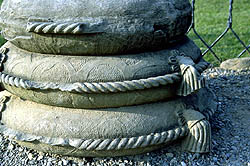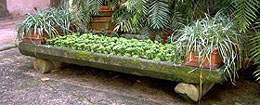|
Subscribe / Renew |
|
|
Contact Us |
|
| ► Subscribe to our Free Weekly Newsletter | |
| home | Welcome, sign in or click here to subscribe. | login |
Landscape Northwest '99
|
|
The Italian garden as theater
By LORNA JORDAN The Italian garden is a theater for ideas and experiences regarding our relationship to nature. For centuries, gardens have been inspired by a diverse set of moral, poetic, social, and philosophical ideas.
From the garden plot for food described in Virgil's Georgics to the aristocratic pleasure gardens of the Renaissance, the Italian garden has been the stage for dramas related to food, fantasy, political prestige, and divinity. The stage is literally set in the cabinet of curiosities, a phenomenon that recurs among late sixteenth and early seventeenth century Italian gardens. A cabinet of curiosity can be defined as a theater, room, or cabinet of wonder that holds collections of art, natural oddities, and unusual objects displayed to evoke the fullness of creation. These were not dry, rational catalogues of objects but imaginative recreations of the world. Some
The landscape historian John Dixon Hunt has specifically connected the cabinet of curiosities with ornaments and features of Italian Renaissance gardens, including the galleries, pavilions, and grottoes made for displaying everything from antique statuary to precious stones. Menageries, botanical gardens, and assortments of minerals were collected in an effort to bring the scattered pieces of creation back together to yield a memory theater of a complete world lost, but reclaimable by human skill.
Villa Caprile in Pesaro has giochi d'acqua, or water games, that are astonishing. The tour guide has a little rod that he pokes down into a series of valves hidden in the ground. Water sprays the visitors from the pathway, banisters, stair steps, planting beds, and finally from a sculptural dolphin's eyes in the grotto. Behind the grotto lies a secret passageway with an elaborate array of piping. Here, the unseen villa owner could watch his guests get drenched. This presents an interesting dynamic of control over nature and, ultimately, other people.
Back to the futureIn the Northwest, there is a strong ethic regarding our relationship with nature. Our attitudes have shifted from the Renaissance view that places humans in dominance over nature towards a more ecological view that places humans within a community of systems
Our infrastructure exerts a strong command over nature, but it is mostly hidden from view. For example, water for drinking and drainage is collected and channeled underground. Can we begin to create places that meld our infrastructure and parks functions? And, if so, can we reveal the wonders of our engineered and natural infrastructure? Can we make our designs theatrical so as to engage people while heightening the experience of the natural world? Can we allow ourselves to blur the distinctions between nature and design to yield places that are magical? The genius of many Italian designers lies in their ability to be artists, storytellers, collectors, organizers, set designers, and collaborators. They use their talents to make places that reveal the wonders of nature and artifice. The Northwest is growing by leaps and bounds, and we have the ability to transform everyday places into something more marvelous. Now is the time to consider alternative ways to imagine and build our future.
Lorna Jordan is an environmental artist who has created a series of installations and public works based on the garden. She cited the following sources in writing this article: Collecting and Display by Alistair McAlpine and Cathy Giangrande, Gardens of Revelation by John Beardsley, Wonders and the Order of Nature by Lorraine Daston and Katherine Park, and The Italian Garden: Art, Design and Culture, edited by John Dixon Hunt.
 djc home | top | special issues index
|





